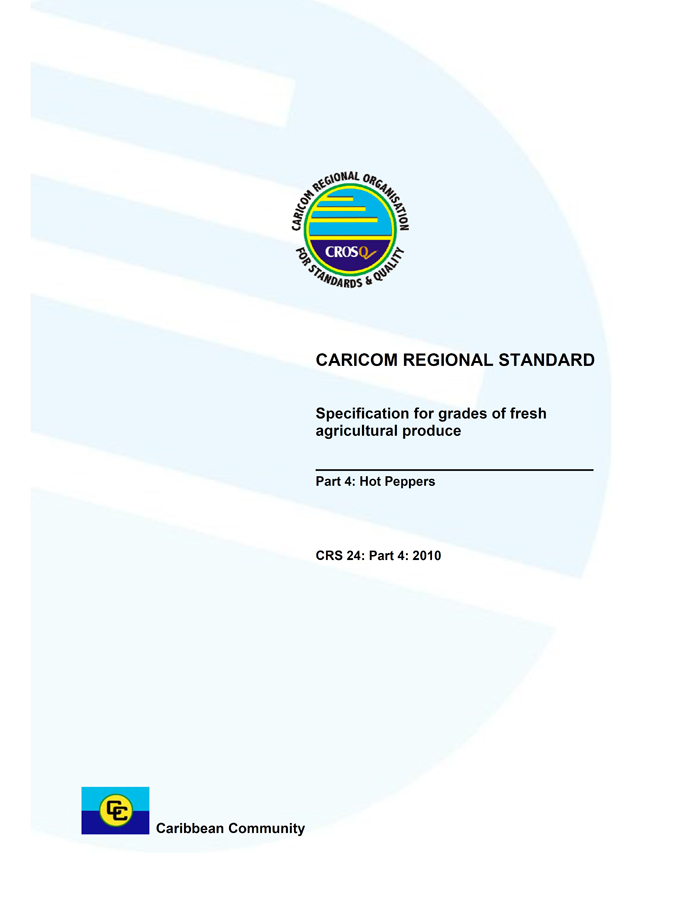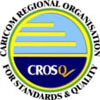
In order to promote public education and public safety, equal justice for all, a better informed citizenry, the rule of law, world trade and world peace, this legal document is hereby made available on a noncommercial basis, as it is the right of all humans to know and speak the laws that govern them.


CARICOM Regional Organisation for Standards and Quality (CROSQ)
2nd Floor Nicholas House
29 & 30 Broad Street
Bridgetown, St Michael
Barbados
T: 246.622.7670 | F: 246.622.7678
Website: http://www.crosq.org
© CROSQ 2010 – All rights reserved
Unless otherwise specified, no part of this publication may be reproduced or utilized in any form or by any means, electronic or mechanical, including photocopying and microfilm, without permission.
CRS 24: Part 4: 2010
CARICOM Regional Organisation for Standards and Quality (CROSQ)
2nd Floor, Nicholas House
29 & 30 Broad Street
Bridgetown, St. Michael
Barbados
T: 246.622.7670 | F: 246.622.7678
Website: http://www.crosq.org
© CROSQ 2010 – All rights reserved. No part of this publication is to be reproduced without the prior written consent of CROSQ.
ISBN 978-976-8234-06-3
ICS 67.080
| AMENDMENT NO. | DATE OF ISSUE | TYPE OF AMENDMENT | NO. OF TEXT AFFECTED | TEXT OF AMENDMENT |
|---|---|---|---|---|
This CARICOM Regional Standard was prepared under the supervision the Regional Technical Committee for Agricultural Commodities (RTC 19), (hosted by the CARICOM Member State, Dominica), which at the time comprised the following members:
| Members | Representing |
|---|---|
| Mr. Lloyd Pascal (Chairperson) | Dominica Export Import Agency (DEXIA) |
| Mr. Ricky Allport | Division of Agriculture, Dominica |
| Mr. Ryan Anselm | Plant Protection and Quarantine Services, Dominica |
| Mr. Kent Coipel | Inter-American Institute for Cooperation on Agriculture (IICA) |
| Mr. Clement Ferreira | Nature’s Best, Dominica |
| Mrs. Marcella Harris | Windward Islands Farmers Association (WINFA) |
| Mr. Cecil Joseph | Dominica Hucksters Association (1995) Ltd. (DHA) |
| Mr. Rawle Leslie | Dominica State College – Agriculture Faculty |
| Dr. Gregory Robin, PhD | Caribbean Research and Development Institute (CARDI) |
| Mr. Delroy Williams | National Association of Youth in Agriculture (NAYA), Dominica |
| Dr. Nadia Pacquette-Anselm (Technical Secretary) | Dominica Bureau of Standards |
| Foreword | 1 | |||
| 1 | Scope | 2 | ||
| 2 | Terms and definitions | 2 | ||
| 3 | Requirements | 3 | ||
| 3.1 | Quality | 3 | ||
| 3.1.1 | Minimum requirements | 3 | ||
| 3.1.2 | Classification | 4 | ||
| 3.1.3 | Tolerances | 4 | ||
| 3.2 | Sizing | 5 | ||
| 3.3 | Packaging and labelling | 5 | ||
| 3.3.1 | Packaging | 5 | ||
| 3.3.2 | Labelling | 5 | ||
| 4 | Contaminants | 6 | ||
| 5 | Hygiene and sanitation | 6 | ||
This CARICOM Regional Standard was developed in an effort to:
This standard was approved by the Twenty-ninth Council for Trade and Economic Development (COTED) on 8-9 February 2010.
In the development of this standard, assistance was derived from the following:
NOTE During the development of this standard, the CARICOM Regional Code of Practice for Food Hygiene was still under development.
1This standard specifies the quality requirements of hot peppers (Capsicum sp.), which are to be supplied fresh to the consumer after preparation and packaging.
The standard does not apply to hot peppers for industrial processing.
The following referenced documents are indispensable for the application of this document. For dated references, only the edition cited applies. For undated references, the latest edition of the referenced document (including any amendments) applies.
CARICOM Regional Code of Practice for Food Hygiene
CODEX Principles for the Establishment and Application of Microbiological Criteria for Foods
For the purposes of this standard, the following terms and definitions shall apply.
any physical injury affecting the surface of the fruit, such as scars, scratches, healed cracks or discoloured spots, which detracts from its natural appearance, but will not significantly affect its shelf life
free from soil, chemical deposits, pest, and any foreign matter
weight placed in the package taking into account the expected natural weight loss and ensuring that the buyer gets the net weight/count stated on the package
any defect or combination of defects of physical or physiological causes which detracts from the edible or marketing quality such as rot, decay, chilling injury, insect damage, healed or open cracks or punctures, bruises, sunscald to the fruit, which could lead to the abnormally quick deterioration of the fruit
weight or diameter required by the market (customer)
not soft, spongy or noticeably wilted
2absence of any visible evidence of moulds, fungal and bacterial rots, spots or any symptom of viral infection
firm, turgid, glossy, bright, and with a green stalk and there are no signs of shrivelling, shrinkage or softness of the fruit
NOTE Hot peppers maintain their reaped appearance and are not withered or showing signs of dehydration.
no signs of insects at any stage of development on or in the hot pepper or in the package
stalk is firmly attached to the fruit with evidence that it was detached at the line of abscission and with no sign of breakage, twisting or damage to the stalk
two or more hot peppers whether or not packaged, but sold as one distinct and separate group
turgid and glossy with thick, bright coloured walls and at a stage of development that will ensure that they arrive on the market in an acceptable condition subject to the expected type of transportation and handling conditions
meets the requirements of the importing country’s legislation and any additional specifications dictated by the importer
hot peppers in a lot have the same general shape, size, colour, flavour, odour and pungency typical of the variety
Hot peppers shall meet or exceed the following minimum requirements, subject to the special provisions in 4.1.3:
Hot peppers shall be classified as Class I and Class II. All classes shall meet the minimum requirements in 4.1.1.
Hot peppers in this class shall be:
Hot pepper in this class shall:
Each class shall be allowed a degree of tolerance as specified below to account for human error in sorting and packing, and for the deterioration in quality that may occur between the point of dispatch and receipt. The degree of tolerance allowed should not be deliberately exploited by the packer.
Hot peppers in this class shall meet the following requirements:
Hot peppers in this class shall meet the following requirements:
Hot peppers shall be sized depending on the variety and market requirement.
Hot peppers shall be packed in such a manner so as to afford protection to the produce. The packaging shall meet the following requirements:
NOTE The use of materials, particularly of paper or stamps, bearing trade specifications is allowed, provided the printing or labelling has been done with non-toxic ink or glue.
Each package of hot peppers shall bear the following particulars, in letters grouped on the same side, legibly and indelibly marked in the official language(s) of the country in which the produce is to be sold, and which are visible from the outside (either printed on the package itself or on a label secured to the package):
NOTE The weight stated on the container is the minimum net weight delivered to the customer.
5Each package for export shall be legibly and indelibly marked on at least two sides.
In addition, labels may include the following information:
EXAMPLE Waxing or fungicide use
NOTE The use of red or orange should be avoided since these colours are used in the labelling of dangerous goods.
All chemicals used pre/post harvest must be registered and approved for use in accordance with Global GAP (Good Agricultural Practices) Standards and the requirements of the national regulation for pesticides of the importing and exporting countries.
Hot peppers shall comply with the maximum levels for contaminants and heavy metals established by the Codex Alimentarius Commission for this commodity.
Hot peppers covered by the provisions of this standard, shall be prepared and handled in accordance with the appropriate clauses of the latest edition of the CARICOM Regional Code of Practice for Food Hygiene or other international Codes of Practice which are relevant to this commodity.
Hot peppers shall comply with the microbiological criteria established in accordance with the latest edition of CODEX Principles for the Establishment and Application of Microbiological Criteria for Foods.
Hot peppers shall comply with Sanitary and Phyto-Sanitary (SPS) requirements of the importing and exporting countries.
6
The CARICOM Regional Organisation for Standards and Quality (CROSQ) was created as an Inter-Governmental Organisation by the signing of an agreement among fourteen Member States of the Caribbean Community (CARICOM). CROSQ is the regional centre for promoting efficiency and competitive production in goods and services, through the process of standardization and the verification of quality. It is the successor to the Caribbean Common Market Standards Council (CCMSC), and supports the CARICOM mandate in the expansion of intra-regional and extra-regional trade in goods and services.
CROSQ is mandated to represent the interest of the region in international and hemispheric standards work, to promote the harmonization of metrology systems and standards, and to increase the pace of development of regional standards for the sustainable production of goods and services in the CARICOM Single Market and Economy (CSME), and the enhancement of social and economic development.
CROSQ VISION:
The premier CARICOM organisation for the development and promotion of an Internationally Recognised Regional Quality Infrastructure; and for international and regional harmonized CARICOM Metrology, Standards, Inspection, Testing and Quality Infrastructure
CROSQ MISSION:
The promotion and development of standards and standards related activities to facilitate international competitiveness and the sustainable production of goods and services within the CARICOM Single Market and Economy (CSME) for the enhancement of social and economic development
7 8